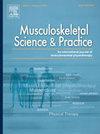内源性镇痛,通过条件疼痛调节评估,与对照组相比,髋关节骨关节炎患者没有什么不同:一项横断面研究
IF 2.2
3区 医学
Q1 REHABILITATION
引用次数: 0
摘要
在膝骨关节炎患者中,疼痛敏感性的测量已被证明与疼痛严重程度和治疗结果相关,这取决于所测试的疼痛敏感性的类型。目的量化髋关节骨关节炎患者与非髋关节骨关节炎患者在压力疼痛阈值(PPT)或条件疼痛调节(CPM)效应上是否存在差异。方法我们在两个地理位置进行了横断面研究。局部(髋部)和远程(肘部)部位的PPTs通过手动测量仪采集。CPM在被测髋关节对侧手冰水浸泡之前和浸泡期间使用PPTs进行量化。我们采用了两个线性混合模型(髋部和肘部)来评估组间(病例与对照组)PPT随时间的差异。p <;0.05.结果我们纳入了71名参与者:32名患有髋关节骨关节炎(75%为女性),39名没有髋关节骨关节炎(82%为女性)。骨关节炎患者的髋关节PPTs基线明显低于对照组(p = 0.038)。条件刺激后,髋关节PPTs随时间显著增加(p <;0.001)。然而,我们没有发现PPTs在组和时间之间有显著的相互作用效应(p = 0.308)。髋骨关节炎患者肘关节PPT与对照组无显著差异(p = 0.114)。条件刺激后肘部PPTs随时间显著增加(p <;0.001)。然而,我们没有发现PPTs在组和时间之间有显著的相互作用(p = 0.606)。结论:本研究表明髋关节骨关节炎患者存在局部而非广泛的机械敏感性增高。CPM组间差异无统计学意义。本文章由计算机程序翻译,如有差异,请以英文原文为准。
Endogenous analgesia, assessed via conditioned pain modulation, is not different in people with hip osteoarthritis compared to controls: a cross-sectional study
Background
In people with knee osteoarthritis, measures of pain sensitivity have been demonstrated to relate to both pain severity and treatment outcomes, dependent on the type of pain sensitivity being tested.
Objective
Quantify if differences in the pressure pain thresholds (PPT) or conditioned pain modulation (CPM) effect exist between people with hip osteoarthritis and age-matched controls without hip osteoarthritis.
Methods
We performed a cross-sectional study across two geographic locations. PPTs at a local (hip) and remote (elbow) site were collected via a manual algometer. CPM was quantified using PPTs immediately prior to, and during ice water immersion of the hand contralateral to the tested hip. We performed two linear mixed models (hip and elbow) to evaluate between-group (case vs control) differences in PPT over time. Significance was accepted with p < 0.05.
Results
We included 71 participants: 32 with hip osteoarthritis (75 % female sex), and 39 without hip osteoarthritis (82 % female sex). Osteoarthritis participants had significantly lower baseline hip PPTs than control participants (p = 0.038). Hip PPTs significantly increased over time following the conditioning stimulus (p < 0.001). However, we did not detect a significant interaction effect for PPTs between group and time (p = 0.308). There were no significant differences detected in elbow PPT between hip osteoarthritis and control participants (p = 0.114). Elbow PPTs significantly increased over time following the conditioning stimulus (p < 0.001). However, we did not detect a significant interaction for PPTs between group and time (p = 0.606).
Conclusion
This study demonstrates that people with hip osteoarthritis have local, but not widespread, increases in mechanical sensitivity. Further there were no group differences in CPM.
求助全文
通过发布文献求助,成功后即可免费获取论文全文。
去求助
来源期刊

Musculoskeletal Science and Practice
Health Professions-Physical Therapy, Sports Therapy and Rehabilitation
CiteScore
4.10
自引率
8.70%
发文量
152
审稿时长
48 days
期刊介绍:
Musculoskeletal Science & Practice, international journal of musculoskeletal physiotherapy, is a peer-reviewed international journal (previously Manual Therapy), publishing high quality original research, review and Masterclass articles that contribute to improving the clinical understanding of appropriate care processes for musculoskeletal disorders. The journal publishes articles that influence or add to the body of evidence on diagnostic and therapeutic processes, patient centered care, guidelines for musculoskeletal therapeutics and theoretical models that support developments in assessment, diagnosis, clinical reasoning and interventions.
 求助内容:
求助内容: 应助结果提醒方式:
应助结果提醒方式:


